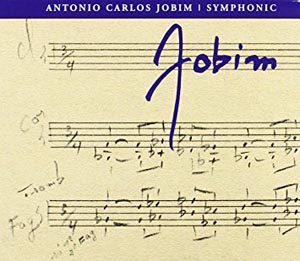 Antonio Carlos Jobim, known widely as “Tom,” was one of the key figures in the popularity of the bossa nova, a style he and his fellows — particularly Joao Gilberto, Luiz Bonfá, and Vinícius de Moraes — created from the musical traditions of Brazil, the urgent and sensuous Afro-Brazilian sambas and the Portuguese ballads with their tinge of Moorish melancholy, as well as modern jazz and the spare harmonies of the Impressionist composers. Jobim was the composer of “Desafinado,” which, in a recording by Stan Getz, put him on the international map. “Girl from Ipanema” then took the world by storm. Jobim was also a composer of more “serious” music, which the two-CD release Symphonic surveys.
Antonio Carlos Jobim, known widely as “Tom,” was one of the key figures in the popularity of the bossa nova, a style he and his fellows — particularly Joao Gilberto, Luiz Bonfá, and Vinícius de Moraes — created from the musical traditions of Brazil, the urgent and sensuous Afro-Brazilian sambas and the Portuguese ballads with their tinge of Moorish melancholy, as well as modern jazz and the spare harmonies of the Impressionist composers. Jobim was the composer of “Desafinado,” which, in a recording by Stan Getz, put him on the international map. “Girl from Ipanema” then took the world by storm. Jobim was also a composer of more “serious” music, which the two-CD release Symphonic surveys.
It is more than a little difficult to describe this music without making it sound derivative, which it is not, particularly — say rather that it is in the modern art music mainstream, so that Jobim’s compositions echo others you may have heard from the 20th century, which was a time of great ferment among composers both in the U.S. and abroad. Art music began incorporating strands from popular forms — jazz, in particular — as well as non-Western influences, especially Asian and Afro-Caribbean traditions. Jobim’s music, with its own solid background in Brazilian vernacular forms, is certainly, in this sense, “mainstream.” In fact, it is those compositions that acknowledge these sources that are the most successful.
The “Overture” to Orfeu da Conceiçáo is perhaps one of the best examples of Jobim’s synthesis of the various influences, offering hints of Gershwin, particularly Porgy and Bess and the Piano Concerto, with a particularly Brazilian feel. “Imagina,” on the other hand, gives a strong sense of some of the lighter works of Claude Debussy without incorporating his characteristic “tone block” method of composition. The following selection, “Matito Perê,” is another that effortlessly blends together rhythms, melodies and moods from a number of traditions; Milton Nacímento’s understated vocals are perfectly suited to this selection.
I can’t really say that this is music that jumps out at you — most of the pieces are understated, marked by flashes of Afro-Caribbean rhythms and sinuous melodies. Jobim’s antecedents in jazz are readily apparent, as are his understanding and appreciation of the currents in modern art music — there are echoes of Gershwin, Ravel, Thomson, even Britten in the colorings and textures he employs.
The album was recorded live at the Sala São Paulo by Roberto Minczuk, conducting members of the Orquestra Sinfônia do Estado de São Paulo. The performers quite obviously have a solid understanding and appreciation of the music, and the quality of the recording is excellent. I do regret, however, the decision to include the applause at the end of each selection, which often destroyed the mood, particularly in some of the more delicate works such as “Matito Perê.”
I can’t honestly say that this is a collection that I will be listening to constantly, although it is certainly not one that I will file and forget. Say it’s one I will enjoy listening to when I need reminding that it really is one world.
(Adventure Music, 2005)
